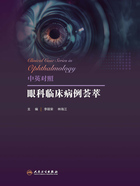
病例25 55岁男性,主诉视力下降多年,且呈晨重暮轻特点
CASE 25 A 55-year-old male complaining of blurry vision especially in the morning for few years
见图1-41。See Fig. 1-41.

图1-41 角膜后表面反射的散在角膜滴状赘疣(guttata),呈金箔样反光,伴角膜中央部基质水肿Fig. 1-41 The posterior surface of the cornea ref lects scattered droplets of the cornea (guttata), ref lecting gold leaf, with edema of the central corneal stroma.
鉴别诊断
Differential Diagnosis
◎ Fuchs角膜内皮营养不良(FECD)(图1-42):一种进展缓慢的常染色体显性疾病,以进行性角膜内皮细胞丢失伴随内皮细胞特征性的赘疣或黑区、角膜水肿及视力丧失为典型表现。发病晚,一般40岁以后发病,10岁以前发病较少。
◎ Fuch’s endothelial corneal dystrophy(FECD)(Fig. 1-42):A rare, slowly progressed autosomal dominant disease,characterized by progressive corneal endothelial cell loss,accompanied with bilateral corneal guttae with stromal edema thickening, and vision loss. Late onset, generally over 40 years old, rarely younger than 10 years old.
◎ 后部多形性角膜营养不良(PPMD):是以常染色体显性遗传和双眼发病为特点,典型发病于儿童时期。主要表现为无症状的角膜后弹力层和内皮面空泡样改变、带状改变和 / 或弥漫性混浊。绝大部分患者稳定且无症状,很少导致视力丧失。
◎ Posterior polymorphous corneal dystrophy(PPMD):An autosomal dominant inheritance and binocular disease,which typically occurs in childhood. Characterized by endothelial vesicular lesion, band lesion and diffused grey opacities in Descemet’s membrane. Most patients are stable and asymptomatic, rarely resulting in vision loss.
◎ 虹膜角膜内皮(ICE)综合征:角膜改变与后部多形性角膜营养不良相似,但通常为单侧,伴进行性虹膜基质萎缩、广泛的周边前粘连、房角关闭和继发性青光眼。
◎ Iridocorneal endothelial(ICE)syndrome: Corneal guttae and stromal thickening are very similar to FECD. However,ICE syndrome is always unilateral, that accompanied with progressive iris stroma atrophy, extensive peripheral anterior iris adhesion, close angle, and secondary glaucoma.

图1-42 共聚焦显微镜表现为角膜内皮细胞增大,其间有滴状病理性暗区形成,遮挡内皮细胞边界Fig. 1-42 Confocal microscope shows:roundish guttae-like dark spots covering endothelial cell boundaries
病史询问
Asking History
◎ 询问视力下降时间,视力降低是否有晨重暮轻的特点;是否有遗传性眼病家族史,如Fuchs角膜内皮营养不良或后部多形性角膜营养不良;是否有青光眼、眼部炎症、眼外伤病史;伴眼部症状的全身性疾病,免疫系统疾病史等。
◎ Generally, the patients with Fuch’s endothelial corneal dystrophy have blurry vision in the morning and gradually improved during the day time. Asking the family history of inherited eye disease such as FECD or PPMD, history of any glaucoma, ocular inf lammation, trauma, systemic disease with ocular manifestations, and immune system disorders.
眼部检查
Examination
◎ 视力、眼压。
◎ Visual acuity, IOP.
◎ 裂隙灯检查:着重观察后弹力层及内皮层是否可见橘皮样反光。内皮面是否有色素沉积,基质是否水肿增厚及伴瘢痕形成。
◎ Slit lamp examination: Focusing on peaud’s orange texture in Descement’s membrane and endothelium, keratic precipitates, cornea stroma edema and scar forming.
◎ 房角镜检查:周边前粘连(PAS)是虹膜角膜内皮综合征最常见的表现,在未关闭的房角可见异常色素沉着;后部多形性角膜营养不良患者也可观察到不同形式的PAS。Fuchs角膜内皮营养不良患者房角常无异常改变。
◎ Gonioscope examination: PAS (peripheral anterior synechia) is the most common manifestation in ICE syndrome, and there will be abnormal pigmentation in unclosed anterior chamber angle; In PPMD patients, PAS in different forms could also be observed. FECD patients have no abnormal change in anterior chamber angle.
◎ 共聚焦显微镜 / 角膜内皮镜:可为鉴别诊断提供直观证据。在Fuchs角膜内皮营养不良中,共聚焦显微镜 / 角膜内皮镜表现为内皮细胞增大,其间有滴状病理性暗区形成,遮挡内皮细胞边界。虹膜角膜内皮综合征患者特征性表现为细胞形态不规则,“明 / 暗倒置”。后部多形性角膜营养不良患者可见内皮层和后弹力层细胞体积增大、结构丧失,囊泡样病变呈弹坑或火山口状。
◎ Confocal microscope/ specular microscope could be used to detect the shape and density of endothelium. In FECD,corneal guttae displayed as enlarged endothelial cells and roundish guttae-like dark spots covering endothelial cell boundaries. Irregular endothelial cells with dark/light reversal were the characteristic pattern in ICE syndrome.PPMD typically appeared as hyporef lective vesicles among enlarged and pleomorphic endothelium in the level of the endothelium and Descemet’s membrane, given a “pit” or“crater” appearance.
诊断
Diagnosis
Fuchs角膜内皮营养不良。
Fuchs endothelial corneal dystrophy.
治疗
Management
◎ 早期的Fuchs角膜内皮营养不良不需要特殊治疗。目前,尚无药物可以阻止角膜营养不良的进展。这一阶段的白内障手术应该由有经验的医生进行,并在手术中注意保护角膜内皮。
◎ In general, early stage of FECD requires no specif ic treatment. Currently, no medication could prevent the progression of the corneal dystrophy. Cataract surgery should be performed by experienced doctor with precautions regarding the endothelium.
◎ 出现角膜水肿时,可采用4%生理盐水或50%葡萄糖等高渗溶液点眼,使角膜脱水。治疗性角膜接触镜有助于缓解出现角膜大泡时的疼痛及不适感。
◎ When cornea edema appeared, 4% saline solution or 50% glucose could be applied to dehydrate the cornea.Therapeutic contact lenses are helpful to relieve eye pain and discomfort in condition of bullous keratopathy.
◎ 如出现严重角膜水肿或大泡破裂导致视力下降,应行角膜内皮移植术。如长期角膜内皮失代偿导致角膜瘢痕形成,须采用穿透性角膜移植手术。
◎ Corneal endothelial transplantation has become the mainstay of surgical treatment for visually signif icant FECD.However, PK is still required for corneal scarring cases due to long-term corneal endothelial decompensation.
患者教育和预后
Patients Education & Prognosis
◎ 本病进展缓慢,早期患者可能无症状且无须治疗,定期复查即可,内皮细胞数需要每3~6个月重新评估1次。如果行白内障手术须谨慎,从保护角膜内皮角度而言,白内障手术宜尽早进行以减轻手术过程对角膜内皮的损伤。但患者须充分了解,即使术中损伤再小也存在术后有角膜内皮功能失代偿的风险,须行角膜内皮移植术。
◎ The disease progresses slowly and there are no specif ic treatment required at early stage. Endoth e lium cell count should be re-evaluated every 3 to 6 months. Cataract surgery should be performed with extra caution. Patients need to fully understand that even a small intraoperative injury may lead to a risk of postoperative endothelial dysfunction and then Descemet stripping endothelial keratoplasty is required.
◎ 本病预后尚好。
◎ The disease has comparatively good prognosis.